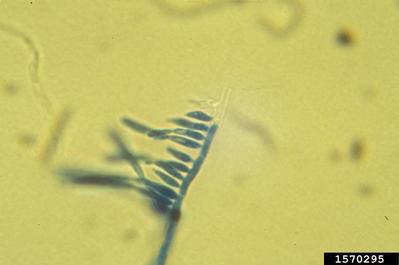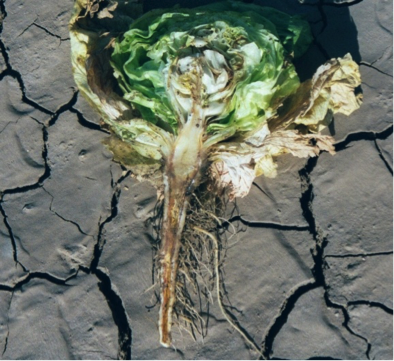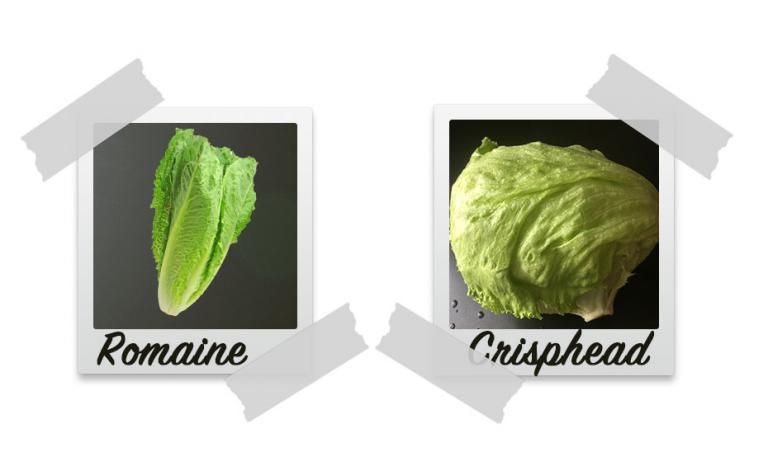Fusarium Wilt of Lettuce
On this page
Connected Pages
Fusarium wilt of lettuce is a relatively new disease of lettuce, having been first described in 1967 in Japan. In Arizona, the disease was first reported in 2001 and has since spread throughout the lettuce production areas of the southwest US. The disease affects all lettuce types but is more prevalent in crisphead and leaf types. Symptoms include severe stunting of lettuce plants with diseased roots showing dark brown streaking and necrosis of the vascular tissue extending from the taproot into the stem. When the disease occurs in seedlings and young lettuce, the plants collapse and die quickly. In mature plants, disease symptoms may not be immediately evident, but will quickly become visible following warm days when the transpiration load is high. At this stage, the disease can be mistaken for lettuce drop caused by Sclerotinia sclerotiorum. However in contrast to lettuce drop, in a Fusarium-infected plant, the lettuce crown will not be completely decayed, there will be no white mycelia growth around the crown and taproot, and there will be no sclerotia visible.
Causal Agent
The disease is caused by the fungus Fusarium oxysporum forma specialis (f.sp.) lactucae. The forma specialis designation refers to the host range of this fungus; each forma specialis is a special form of the common soilborne fungus Fusarium oxysporum, which occurs worldwide. There are many special forms of Fusarium oxysporum, each with a unique host. The forma specialis lactucae infects only lettuce. Whereas the non-pathogenic form of Fusarium oxysporum is widely distributed, the special forms are not but only occur in areas where their specific hosts are regularly planted. All forms of Fusarium oxysporum can live off of soilborne organic matter for long periods, and consequently, once pathogenic forms are introduced into different areas, they persist in the soil for many years, even in the absence of their hosts.

The fungus infects lettuce through the root system and can infect at any stage of growth. Once inside the plant, the fungus grows up into and throughout the plant vascular system, which results in occlusion and reduced ability of the plant to move water. The tissue surrounding the vascular system also becomes necrotic. Once the vascular system is completely occluded, the plant can no longer transpire and dies. The fungus is also seedborne and can be transported long distance to new production areas via contaminated seed. As the fungus grows in the soil and in infected plants, it produced an abundance of soilborne spores, which function as new inoculum in subsequent infections of other plants. The fungus also produces special spores known as chlamydospores, which are larger, more rounded, with thicker walls than regular spores. These chlamydospores are especially durable and can remain quiescent in the soil for many years before germination.

Management Practices
Cultural Control
Cultural control of the disease begins with the prevention of field infestation. As the pathogen is not readily airborne, the spread of the disease is through spreading contaminated soil or contaminated seed. To prevent spread, all soil should be removed from field equipment once the equipment leaves fields known to harbor the pathogen. In addition, seeds should be tested for contamination if produced in areas where the pathogen is known to occur. Since the fungus lives indefinitely on decayed organic debris, all residue from previous crops should be either tilled into the soil or removed from the production areas.
Once a field is infested, the pathogen will persist for many years. Recent studies have shown that soil population levels can be reduced with either extended flooding during summer fallow or with extended periods of dry fallow. The disease appears to be more severe during the warmer early fall planting in contrast to the cooler early winter planting. Therefore, if a suspected contaminated field is considered for planting, seeding should be delayed until cooler early winter temperatures become established.
Chemical Control
Although the fungus appears to be sensitive to many broad-spectrum fungicides in the laboratory, these products have limited efficacy in the field. This is most likely due to difficulty in getting the product to the root zone at an effective concentration. Recent studies with plant defense activators have shown moderate success and continued work with these products is promising.
Biological Control
There are a number of biological control agents that have been shown to be effective against a wide range of fungal species, such as strains of the fungus Trichoderma and strains of the bacterium Bacillus. In greenhouse studies, several strains of the mycoparasitic fungus Trichoderma and the bacterium Streptomyces consistently reduced the impact of the disease. In addition, the use of a non-pathogenic strain of Fusarium oxysporum also had significant effects on the expression of the disease. However, in field trials under production conditions, the efficacy in suppressing Fusarium wilt in lettuce with these products singly or in combination has not been demonstrated to any substantial level.
Breeding for Resistance
Effective management of Fusarium wilt diseases in various crops is often accomplished through the development of disease-resistant cultivars. Efforts to develop disease resistance in lettuce cultivars have been ongoing for a number of years. Evaluation of lettuce types and cultivars has revealed a range of responses. A number of trials have shown that romaine types are more tolerant to infection and many of these cultivars do not show disease symptoms strongly. In contrast, few crisphead or leaf types demonstrate any level of resistance at all. However, in a 2016 variety trial conducted in a heavily infested field, two crisphead cultivars showed high levels of resistance, comparable to that of romaine type lettuces. This is a very encouraging effort.

